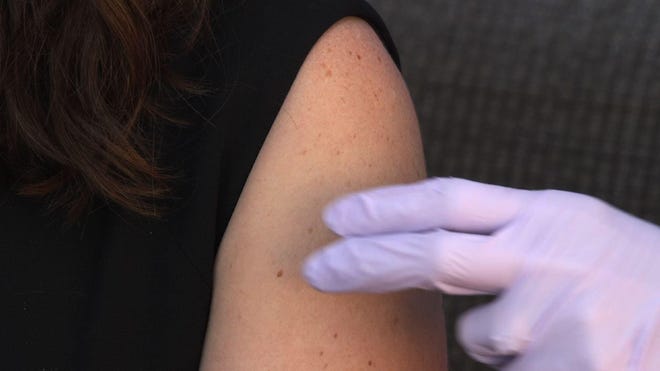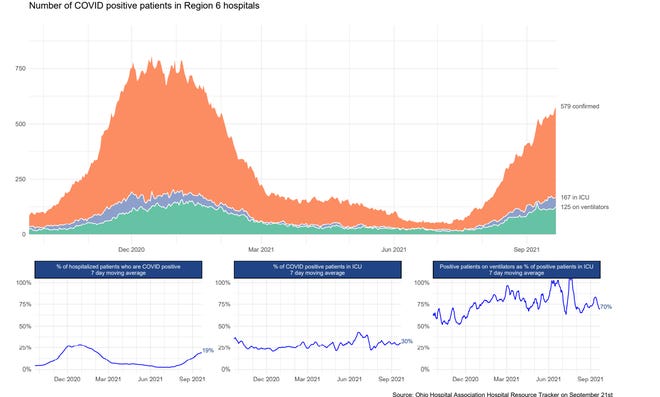
As the Cincinnati region's roughly 500 intensive care beds once again are 100% full, Cincinnati-area health care officials said Wednesday the region could face a "twindemic" of flu and COVID-19 cases this fall and winter.
The concern comes UC Health has already seen some influenza cases as the season gets underway, said Dr. Richard Lofgren, the health system's president and chief executive officer, at Hamilton County's periodic pandemic briefing.
Hamilton County Health Commissioner Greg Kesterman sounded the alarm once more about the state of the region's hospitals, which are packed with COVID-19 cases. Hamilton County, and much of the region, is far above the federal measure for the spread of the virus. "We should use this as a constant reminder that COVID is in our community, and we are recommending caution when you go our and about," he said.
More: Masking curbs COVID-19 in school, study shows
More: Questions answered about kids and COVID-19 vaccines
The flu season has arrived, and Lofgren said the hospitals already are seeing flu patients, although guessing the severity of a season is an annual exercise. Last year, the first winter with the novel coronavirus sweeping the nation, masking and social distancing crushed the flu virus barely more than 100 hospitalizations statewide. The year before, more than 11,000 people needed hospital care for flu.

Some researchers in France have warned of an "immunity debt" as contagion restrictions to exposure to viruses have lifted. Lofgren said, "There is a real concern of a 'twindemic,' if you will," although he noted that flu intensity is tough to predict in normal years.
Kesterman said he expects more flu this year because fewer people are wearing masks in public. The unprecedented low season last year "is just one more piece of evidence that masks did a great job at slowing infection. It's not 100%. ... Most schools are coming around. Most schools have masks, that should help us some."
Lofgren asked people to "get a flu shot and follow the good hygiene practices that we know work."
More:Employers start to enforce vaccine mandates around Cincinnati
More: Where to find a free COVID-19 test
As COVID-19 cases surge again in the Cincinnati region, the area's hospitals are nearing 600 patients with the novel coronavirus. That's less than the 800 at the peak of the winter surge in December 2020.
The hospitals last year worried about having enough equipment and beds. This year, they have staffing issues, Lofgren said. Some workers that went through that surge have retired, and others "are just exhausted" after months of overtime work, Lofgren said.
Now, local hospitals systems haven't stopped nonessential surgeries and procedures, Lofgren said, because "We need to continue to take care of people" who don't have COVID-19 because critical conditions can't wait.

As of Wednesday, there are more than 9,000 active COVID-19 cases in the county. "We are certainly putting a lot of stress on our system," Kesterman said.
Data from the Health Collaborative, a coalition of the six health systems in the Cincinnati area, illustrates that strain as pandemic cases in the region are at their highest levels since late January, according to data from Johns Hopkins University's COVID-19 tracking project. See a chart of rates of new COVID-19 cases in the last seven days by county at the end of this story.
To show how the fourth wave of the COVID-19 pandemic across the region has hit hospital ICUs, consider these numbers from the Health Collaborative's Situation Dashboard:
On July 19, there were 20 COVID-19 patients in local ICUs. On Aug. 18, there were 87. On Sept. 21, the most recent date for which data is available, there were 167.
The region has 513 ICU beds, so the current operating status of 100% means there are 513 ICU patients. The region has the ability to operate its ICUs at 107% of capacity – or add another 36 patients.
The number of in-house COVID-19 patients on Sept. 21 was 579, up 43% from Sept. 1. The patient count on Sept. 1 of 404 was up from 363 on Aug. 25; it also was up 303 on Aug. 18.
The region's hospitals continue to have a slight cushion of empty medical-surgical beds. Those nearly 2,500 beds were 95% occupied on Sept. 21. On Sept. 1, they were 97% occupied.

The local seven-day rate of positive COVID-19 cases now is 11.3%, down slightly from 11.7% last week but up from 9.5% three weeks ago.
Where is COVID-19 especially strong now?
The Health Collaborative's dashboard identifies local ZIP codes with the highest per capita rates of cases over the last 14 days.
On Sept. 21, those were 45204 (Lower Price Hill, Sedamsville, Riverside and part of East Price Hill), 45232 (Spring Grove Village and Winton Hills), 45225 (Camp Washington, Villages at Roll Hill, East Westwood, Millvale and part of North Fairmount), 45205 (parts of East Price Hill and West Price Hill) and 45214 (West End and South Fairmount).
All five of those ZIP codes are in the city of Cincinnati. Four of those ZIPs have had the highest level of cases in the county for the last five weeks.
The vaccination rates in each of those five ZIPs are below 40%. In 45225 and 45232, the vaccination rates are below 30%, according to the Health Collaborative's dashboard.
The ZIP code with the highest rate of cases in Hamilton County is outside the city: 45001 (Addyston). The vaccination rate there is just over 40%.
Source link








